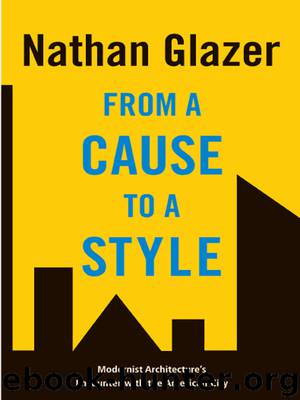From a Cause to a Style by Nathan Glazer

Author:Nathan Glazer [Glazer, Nathan]
Language: eng
Format: azw3
Publisher: Princeton University Press
Published: 2009-01-09T16:00:00+00:00
CHAPTER SIX
Daniel P. Moynihan and Federal Architecture
Daniel P. Moynihan, who served in the U.S. Senate from 1977 to 2001, probably had a greater influence on federal architecture than any other major public figure of the second half of the twentieth century. His retirement from the Senate in 2001 occasioned deep regret among architects, urbanists, and federal officials dealing with architecture and urban design in various departments of government. For decades, Moynihan was the one major influential elected official they could speak to and who could be expected to have an understanding and appreciation of what they were trying to tell him. He was unique among the members of the U.S. Congress in his high estimate of the role of architecture in government, and in his support for high achievement, both in the building of the past and in the current work of building for government. He would respond to calls about major buildings in danger, and exerted his influence to find new uses for them so they could survive. It is possible that he was the only member of the Senate who would have known that the massive and magnificent Customs House building on the tip of Manhattan, abandoned when the customs service moved into a new building in the World Trade Center, was designed by Cass Gilbert, the architectof the Woolworth Building and the Federal Courthouse in New York City, and he was one of the few who would have cared. (Indeed he did succeed in finding a new use for it, and in saving it.)
In his first year in the Senate, walking around Buffalo, as we are told by Robert A. Peck, who worked for him, "he spied the dilapidated Prudential building, one of the best-known . . . early skyscrapers by . . . Louis Sullivan. Moynihan told Buffalo's Mayor that if the city could see to it that the building was rehabilitated, people the world over would come to Buffalo to see it. (The Mayor is reported to have replied with an eight-letter bovine reference.)"1 Moynihan may have been too extravagant in describing what a restored Prudential building could do for a declining Buffalo, but he did succeed in getting the building restored, and crucial in saving it was Moynihan's decision to put his own western New York office into it. When I visited it some years ago, I discovered that his staff maintained for his visits the excellent guide to Buffalo's architecture by Reyner Banham. They showed it to me, and it was remarkably well worn. The Senator, I was told, made use of it whenever he came to Buffalo.
We are very far from being able to clearly delineate the full range of his various roles affecting federal architecture, and the full scale of his influence. None of his official positions gave him any significant or formally recognized platform for intervention in such matters. We can scroll through his various federal posts—assistant to Secretary of Labor Arthur Goldberg in the Kennedy administration, then Assistant Secretary
Download
This site does not store any files on its server. We only index and link to content provided by other sites. Please contact the content providers to delete copyright contents if any and email us, we'll remove relevant links or contents immediately.
| Anthropology | Archaeology |
| Philosophy | Politics & Government |
| Social Sciences | Sociology |
| Women's Studies |
Cecilia; Or, Memoirs of an Heiress — Volume 1 by Fanny Burney(32434)
Cecilia; Or, Memoirs of an Heiress — Volume 2 by Fanny Burney(31871)
Cecilia; Or, Memoirs of an Heiress — Volume 3 by Fanny Burney(31852)
The Great Music City by Andrea Baker(31340)
We're Going to Need More Wine by Gabrielle Union(18967)
All the Missing Girls by Megan Miranda(15565)
Pimp by Iceberg Slim(14393)
Bombshells: Glamour Girls of a Lifetime by Sullivan Steve(13972)
Talking to Strangers by Malcolm Gladwell(13222)
Norse Mythology by Gaiman Neil(13204)
Fifty Shades Freed by E L James(13157)
For the Love of Europe by Rick Steves(12950)
Mindhunter: Inside the FBI's Elite Serial Crime Unit by John E. Douglas & Mark Olshaker(9200)
Crazy Rich Asians by Kevin Kwan(9167)
The Lost Art of Listening by Michael P. Nichols(7406)
Enlightenment Now: The Case for Reason, Science, Humanism, and Progress by Steven Pinker(7228)
The Four Agreements by Don Miguel Ruiz(6630)
Bad Blood by John Carreyrou(6552)
Weapons of Math Destruction by Cathy O'Neil(6142)
